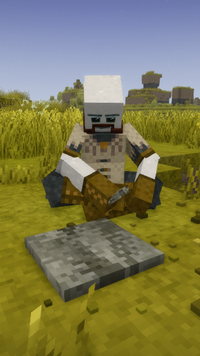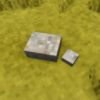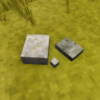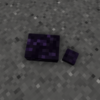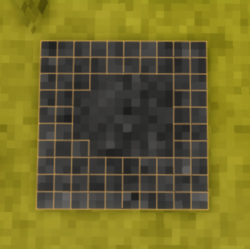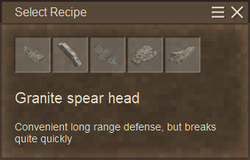Knapping/de: Difference between revisions
(Created page with "==Steinbeschaffung== Lockere Steine, Feuerstein und Obsidian kann man auf dem Boden finden, wenn man auf Nahrungssuche ist. Du kannst sie einsammeln, indem du die linke Mausta...") |
(Created page with "== Klopfbare Steine== Für die Herstellung von Werkzeug- und Waffenköpfen können nur bestimmte Materialien verwendet werden: :{| class="wikitable" |- ! width: 40px | Bild !...") |
||
| Line 9: | Line 9: | ||
Die besten Steine zum Knappen sind in der Reihenfolge der resultierenden Werkzeugstärke: '''Obsidian > Feuerstein > Alle anderen Steinsorten.''' | Die besten Steine zum Knappen sind in der Reihenfolge der resultierenden Werkzeugstärke: '''Obsidian > Feuerstein > Alle anderen Steinsorten.''' | ||
== | == Klopfbare Steine== | ||
Für die Herstellung von Werkzeug- und Waffenköpfen können nur bestimmte Materialien verwendet werden: | |||
:{| class="wikitable" | :{| class="wikitable" | ||
|- | |- | ||
! width: 40px | | ! width: 40px | Bild | ||
! width: 200px | Material | ! width: 200px | Material | ||
! width: 200px| | ! width: 200px| Beschreibung | ||
|- | |- | ||
| style="text-align:center;" | [[File:LooseStones.png|100px]] | | style="text-align:center;" | [[File:LooseStones.png|100px]] | ||
| style="text-align:center;" | | | style="text-align:center;" | Steine | ||
| | | Das gängigste Material, wobei nur bestimmte Gesteinsarten verwendet werden können sind: Granit, Andesit, Hornstein, Basalt und Peridotit. Andere Gesteinsarten können zu weich zum Klopfen sein, z. B. Kreide, Konglomerat, Kalkstein, Tonstein, Sandstein, Schiefer, Phyllit, Schiefer, Kimberlit, Schlacke, Tuff, Bauxit, Halit, Suevit und Marmor. | ||
|- | |- | ||
| style="text-align:center;" | [[File:LooseFlint.png|100px]] | | style="text-align:center;" | [[File:LooseFlint.png|100px]] | ||
| style="text-align:center;" | | | style="text-align:center;" | Feuerstein | ||
| | | Etwas weniger häufig. Kann häufig zusammen mit anderen losen Steinen oder einzeln gefunden werden. Etwas besseres Material für die Herstellung von Werkzeugköpfen, und im Gegensatz zu Steinen kann man daraus Pfeilspitzen herstellen. | ||
|- | |||
|- | |- | ||
| style="text-align:center;" | [[File:LooseObsidian.png|100px]] | | style="text-align:center;" | [[File:LooseObsidian.png|100px]] | ||
| style="text-align:center;" | Obsidian | | style="text-align:center;" | Obsidian | ||
| | | Am häufigsten findet man es in Gebieten, in denen die oberste Gesteinsschicht aus Basalt besteht. Es ist das beste nicht metallische Material für Werkzeuge. | ||
|} | |} | ||
Revision as of 13:54, 6 January 2022
Es ist Zeit, deine ersten Werkzeuge herzustellen! Das knapping ist eine der frühesten Handwerksarten, die dem Spieler zur Verfügung stehen, um primitive Werkzeuge und Waffen aus Stein herzustellen zu können.
Steinbeschaffung
Lockere Steine, Feuerstein und Obsidian kann man auf dem Boden finden, wenn man auf Nahrungssuche ist. Du kannst sie einsammeln, indem du die linke Maustaste drückst.
Die besten Steine zum Knappen sind in der Reihenfolge der resultierenden Werkzeugstärke: Obsidian > Feuerstein > Alle anderen Steinsorten.
Klopfbare Steine
Für die Herstellung von Werkzeug- und Waffenköpfen können nur bestimmte Materialien verwendet werden:
Shaping Stones
- To start knapping, you need at least 2 of the same knappable material (flint, granite, andesite, chert, basalt, peridotite or obsidian) and, while holding them, Sneak + Right-Click on the ground. If you’re using flint, you will begin knapping right away. With other stones, you have to place one stone one the ground first and press Right-Click on it with the second one in your hand.
- After doing this, a dialog box will show up, letting you choose what tool head you want to make by clicking on it.
- Once you've selected a tool, a 10x10 flat grid of voxels will appear on the ground, some of them highlighted with an orange outline. While holding another stone of the same or any material, knap away voxels either by holding down or clicking at your own pace, until no highlighted voxel remains. You can break away groups of voxels by disconnecting them from the main work piece.Consider sitting down using G to get closer to the crafting surface. If you find the free camera distracting while knapping, you can open any dialog box (such as the chat) or hold down Alt to unlock the free mouse.
- Once you're done you will receive your tool head.
Protip:
* The stone used to remove voxels doesn't need to be of the same or even a knappable material (e.g. sandstone, conglomerate, etc.). * Don't worry about making mistakes, the game prevents players from breaking the parts required to shape the tool. * In multiplayer, if another player has knapping stones, they can also work on the piece to complete the tool head faster. When the tool head is completed, it will jump into the inventory of the player who removes the last voxel. |
Finishing the Tool
Once you're done and received your tool head, place it into the crafting grid in your inventory (E) with a stick or bone to receive your finished tool. With flint, players can make an axe, hoe, knife, shovel, spear and arrowheads. With any other stone, players can make all of the tools listed above except arrowheads. Tool heads made of flint or obsidian tend to last longer than counterparts made of andesite, basalt, chert, granite, or peridotite; and tools with a bone handle tend to have 10 points of extra durability
Video Tutorial: How to Knap Stone Tools
Thanks to SmileOnSpeedDial for creating and sharing with the VS community!
| {{{title}}} | |
|---|---|
